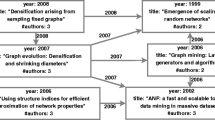Abstract
Citation count is one of the essential factors in understanding and measuring the impact of a scientist or a publication. Estimating the future impact of scientists or publications is crucial as it assists in making decisions about potential awardees of research grants, appointing researchers for several scientific positions, etc. Many studies have been proposed to estimate publication’s future citation count; however, limited research has been conducted on forecasting the citation-based influence of the scientists. The authors of the scientific manuscripts are connected through common publications, which can be captured in dynamic network structures with multiple features in the nodes and the links. The topological structure is an essential factor to consider as it reveals important information about such dynamic networks, such as the rise and fall in the network properties like in-degree, etc., over time for nodes. In this work, we have developed an approach for predicting the citation count of scientists using topological information from dynamic citation networks and relevant contents of individual publications. This framework of the citation count prediction is formulated as the node classification task, which is accomplished by using seven machine learning-based classification models for various class categories. The highest average accuracy of 85.19% is achieved with the XGBoost classifier on the High Energy Physics - Theory citation network dataset.
Access this chapter
Tax calculation will be finalised at checkout
Purchases are for personal use only
Similar content being viewed by others
References
Ibáñez, A., Larrañaga, P., Bielza, C.: Predicting the h-index with cost-sensitive naive Baye. In: 11th International Conference on Intelligent Systems Design and Applications, pp. 599–604 (2011). https://doi.org/10.1109/ISDA.2011.6121721
Fu, L.D., Aliferis, C.F.: Using content-based and bibliometric features for machine learning models to predict citation counts in the biomedical literature. Scientometrics 85, 257–270 (2010). https://doi.org/10.1007/s11192-010-0160-5
Chakraborty, T., Kumar, S., Goyal, P., Ganguly, N., Mukherjee, A.: Towards a stratified learning approach to predict future citation counts. In: IEEE/ACM Joint Conference on Digital Libraries, pp. 351–360 (2014). https://doi.org/10.1109/JCDL.2014.6970190
Bhat, H.S., Huang, L.H., Rodriguez, S., Dale, R., Heit, E.: Citation prediction using diverse features. IEEE Int. Conf. Data Mining Worksh. (ICDMW) 2015, 589–596 (2015). https://doi.org/10.1109/ICDMW.2015.131
Shetty, R.D., Bhattacharjee, S., Dutta, A., Namtirtha, A.: GSI: An influential node detection approach in heterogeneous network using covid-19 as use case. IEEE Trans. Comput. Soc. Syst. (2022). https://doi.org/10.1109/TCSS.2022.3180177
Shetty, R. D., Bhattacharjee, S.: A weighted hybrid centrality for identifying influential individuals in contact networks. In: 2022 IEEE International Conference on Electronics, Computing and Communication Technologies (CONECCT), Bangalore, India, pp. 1–6 (2022). https://doi.org/10.1109/CONECCT55679.2022.9865749
Chen, J., Zhang, C.: Predicting citation counts of papers. In: 2015 IEEE 14th International Conference on Cognitive Informatics & Cognitive Computing (ICCI*CC), pp. 434–440 (2015). https://doi.org/10.1109/ICCI-CC.2015.7259421
Zhu, X.P., Ban, Z.: Citation count prediction based on academic network features. In: 2018 IEEE 32nd International Conference on Advanced Information Networking and Applications (AINA), pp. 534–541 (2018). https://doi.org/10.1109/AINA.2018.00084
Bütün, E., Kaya, M., Alhajj, R.: A supervised learning method for prediction citation count of scientists in citation networks. IEEE/ACM Int. Conf. Adv. Soc. Netw. Anal. Mining (ASONAM) 2017, 952–958 (2017)
Bütün, E., Kaya, M.: Predicting citation count of scientists as a link prediction problem. IEEE Trans. Cybernet. 50(10), 4518–4529 (2020). https://doi.org/10.1109/TCYB.2019.2900495
Soares, P.R.S., Prudêncio, R.B.C.: Proximity measures for link prediction based on temporal events. Exp. Syst. Appl. 40(16), 6652–6660 (2013). https://doi.org/10.1016/j.eswa.2013.06.016. ISSN 0957-4174
P. Ganeshkumar, A. K. BR, S. Padmanabhan and V. A, "Social Media Personal Event Notifier Using NLP and Deep Learning", 2022 International Conference on Power, Energy, Control and Transmission Systems (ICPECTS), Chennai, India, 2022, pp. 1–5, doi: 10.1109/ICPECTS56089.2022.10047710
HEP-Th Dataset. https://snap.stanford.edu/data/cit-HepTh.html. Accessed Sept 2022
HEP-Th Dataset Metadata. https://www.kaggle.com/datasets/tayorm/arxiv-papers-metadata. Accessed Sept 2022
Sarker, I.H.: Machine learning: Algorithms, real-world applications and research directions. SN Comput. Sci. 2, 160 (2021). https://doi.org/10.1007/s42979-021-00592-x
Nikam, U.V., Deshmuh, V.M.: Performance evaluation of machine learning classifiers in malware detection. In: IEEE International Conference on Distributed Computing and Electrical Circuits and Electronics (ICDCECE) 2022, pp. 1–5 (2022). https://doi.org/10.1109/ICDCECE53908.2022.9793102
Author information
Authors and Affiliations
Corresponding author
Editor information
Editors and Affiliations
Rights and permissions
Copyright information
© 2023 IFIP International Federation for Information Processing
About this paper
Cite this paper
Dewangan, S.K., Bhattacharjee, S., Shetty, R.D. (2023). A Temporal Metric-Based Efficient Approach to Predict Citation Counts of Scientists. In: Maglogiannis, I., Iliadis, L., MacIntyre, J., Dominguez, M. (eds) Artificial Intelligence Applications and Innovations. AIAI 2023. IFIP Advances in Information and Communication Technology, vol 675. Springer, Cham. https://doi.org/10.1007/978-3-031-34111-3_29
Download citation
DOI: https://doi.org/10.1007/978-3-031-34111-3_29
Published:
Publisher Name: Springer, Cham
Print ISBN: 978-3-031-34110-6
Online ISBN: 978-3-031-34111-3
eBook Packages: Computer ScienceComputer Science (R0)





